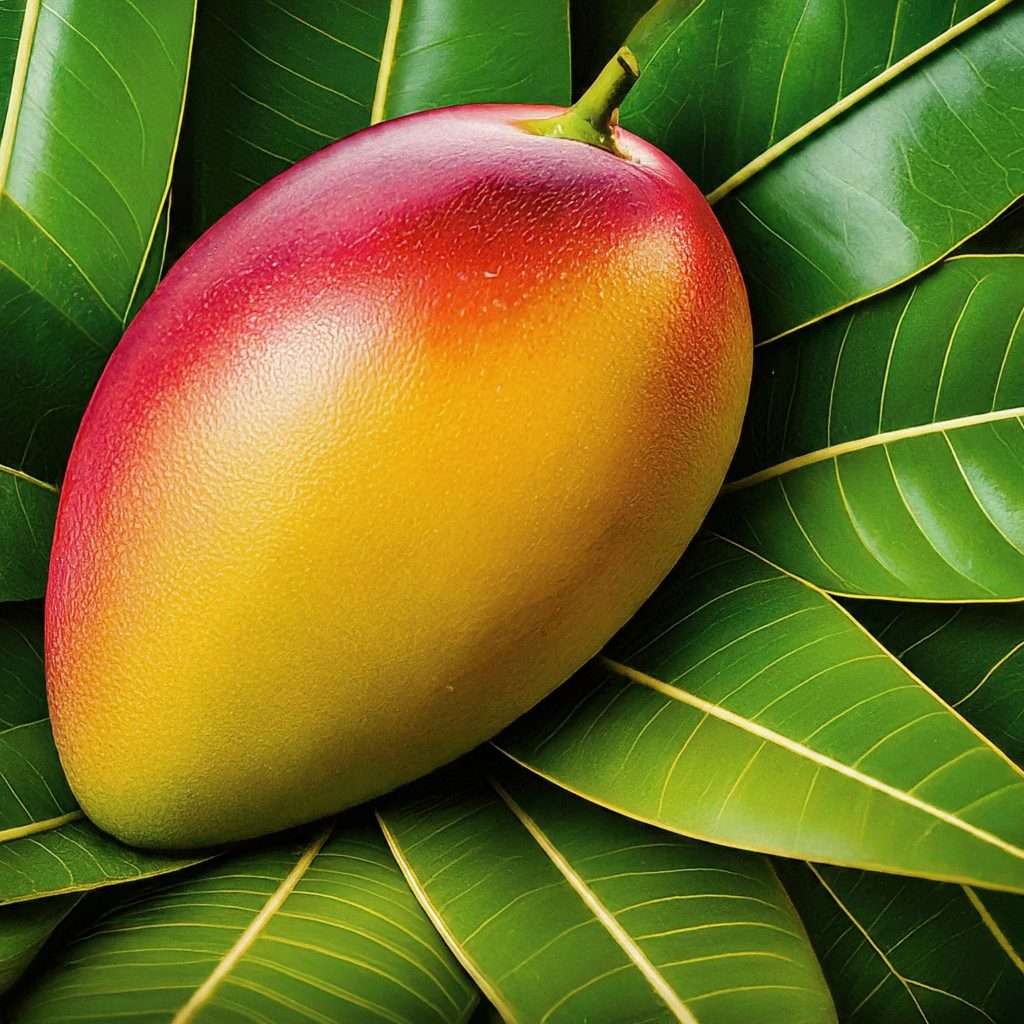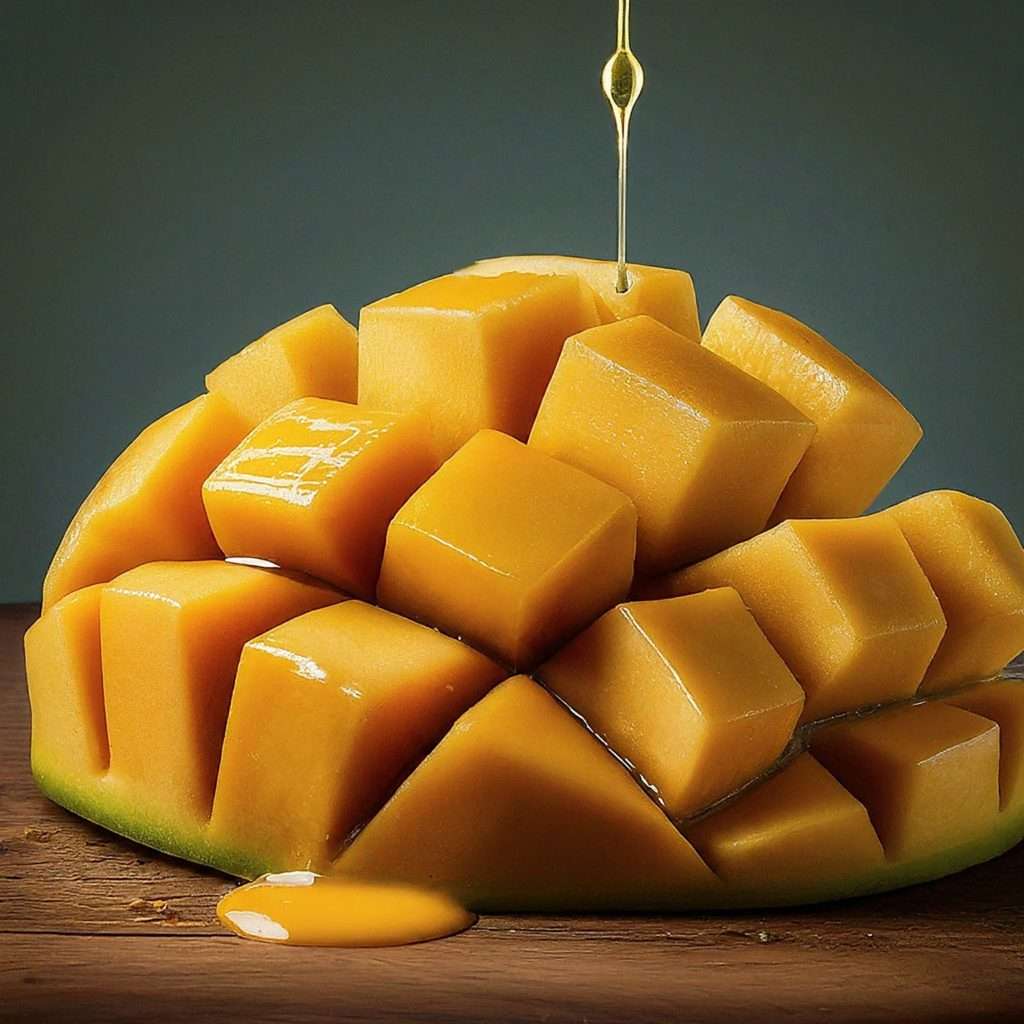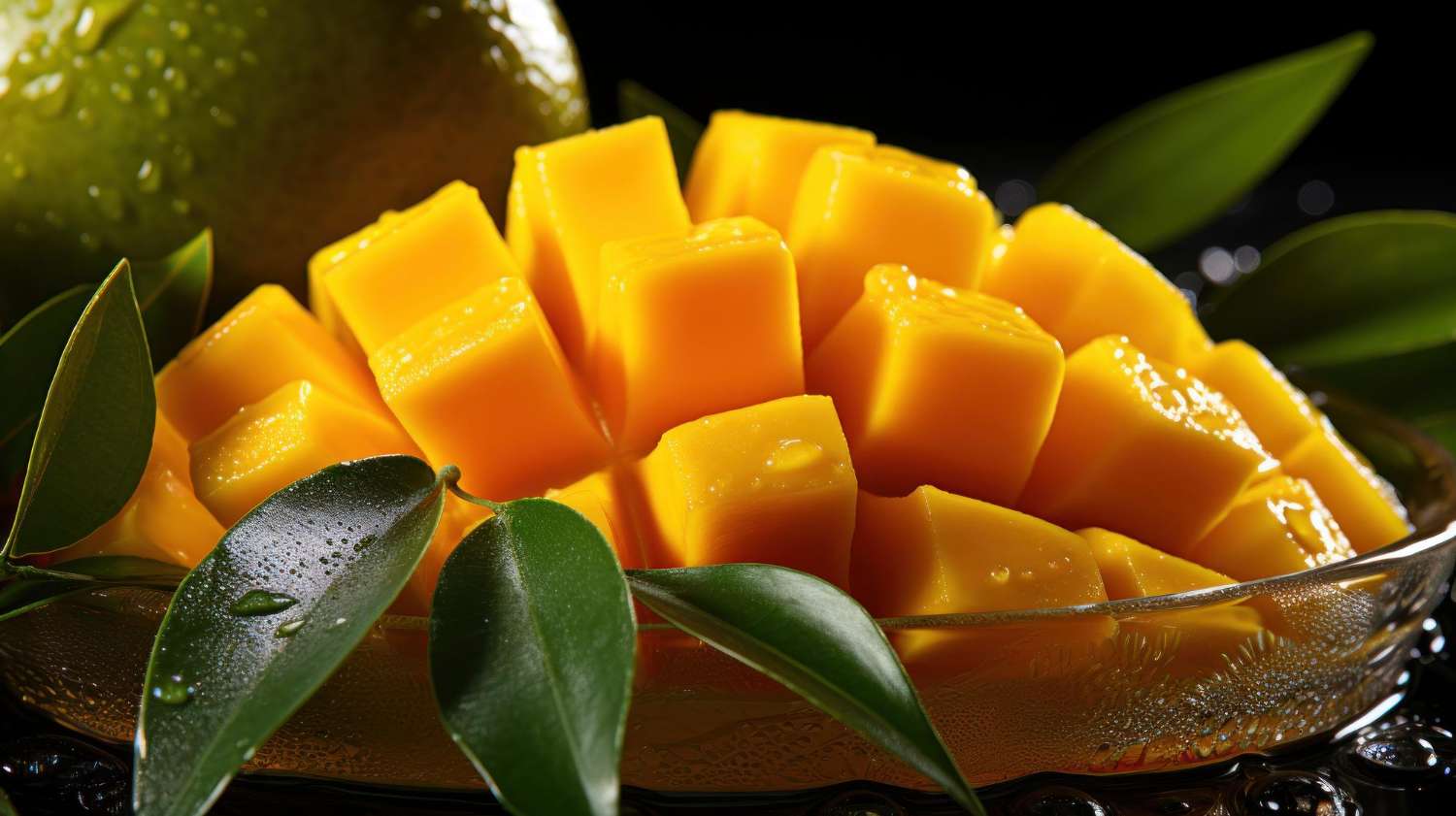I. Introduction
A. The Magnetic Mango
Few fruits ignite the senses quite like the mango. Its vibrant hues, from sunshine yellow to blushing red, entice the eye. The intoxicating aroma, a complex blend of sweetness and tropical earthiness, awakens the olfactory senses. And then there’s the taste – a symphony of juicy sweetness, sometimes tinged with a hint of tartness, that tantalizes the taste buds. It’s no wonder the mango has captivated humankind for millennia.
Across cultures and continents, the mango transcends mere sustenance. It’s a symbol of love, fertility, and prosperity. In India, it’s revered as the “King of Fruits.” Mango festivals erupt in joyous celebrations across Southeast Asia, and its presence graces religious ceremonies and cultural events worldwide.

B. Mango Mischief or Mango Magic?
The allure of the mango extends beyond the physical realm. Legends and folklore weave tales of its mystical properties. In some cultures, it’s believed to possess aphrodisiac qualities, while others credit it with the power to ward off evil spirits. Yet, conflicting information about its nutritional value abounds.
C. Importance of Separating Fact from Fiction
To fully appreciate this tropical treasure, we must distinguish fact from fiction. Are mangoes magical health boosters, or do they contribute to weight gain? Is their sweetness a detriment to healthy eating, or does it offer a hidden benefit? Understanding the true nature of mangoes empowers us to make informed dietary choices and appreciate their cultural significance. By separating fact from fiction, we can celebrate the mango not just for its taste, but for its rich history and potential health benefits.
II. The Legend of the Mango
A. Mythological and Historical References
The mango boasts a history as rich and vibrant as its flesh. Ancient Indian texts like the Rigveda, dating back to 1500-1100 B.C.E., mention the fruit, hinting at its cultivation even earlier. Buddhist scriptures depict Buddha seeking enlightenment under the shade of a mango tree, solidifying its association with peace and wisdom.
The mango’s journey westward is well documented. Alexander the Great’s soldiers, encountering the fruit in India around 327 B.C.E., are credited with introducing it to the West. From there, it spread through trade routes, captivating palates across continents. Arab traders carried it to East Africa and the Middle East, while Portuguese explorers introduced it to Southeast Asia and eventually, the Americas.
B. Cultural Significance in Different Parts of the World
The mango’s impact transcends mere consumption. It has woven itself into the cultural fabric of societies worldwide. In India, it’s the national fruit, symbolizing love, fertility, and good luck. During weddings, mango leaves are exchanged, and doorways are adorned with mango leaf torans (garlands) to usher in blessings. In Southeast Asia, unripe mangoes symbolize hospitality, offered to guests as a gesture of welcome. Ripe mangoes, on the other hand, represent prosperity and are often included in celebratory offerings.
C. How Legends and Stories Shape Perceptions of Mangoes
Legends and stories surrounding the mango contribute to its mystique. The belief that Buddha attained enlightenment under a mango tree reinforces its association with peace and wisdom. In Hindu mythology, the mango tree, Kalpavriksha, is considered a wish-granting tree, further emphasizing its auspicious nature. These stories not only shape cultural perceptions but also fuel the perception of mangoes as possessing almost magical properties. This rich tapestry of myth and history adds depth to the mango’s allure, making it more than just a delicious fruit.
III. Nutritional Facts about Mangoes: Sweetness with Substance
A. Overview of Mango Nutrition
Beyond their captivating taste and cultural significance, mangoes offer a treasure trove of essential nutrients. A single cup (165 grams) of sliced mango packs a powerful punch. It boasts over two-thirds of the daily recommended Vitamin C, a critical antioxidant that supports immune function and promotes healthy skin. This same serving also provides a significant portion of Vitamins A, B6, and E, all vital for maintaining overall well-being.

The nutritional magic doesn’t stop there. Mangoes are a good source of dietary fiber, which aids digestion, promotes satiety, and helps regulate blood sugar levels. They also contribute a respectable amount of potassium, a mineral essential for maintaining healthy blood pressure and muscle function. Additionally, copper, another essential mineral found in mangoes, plays a role in energy production and connective tissue formation.
B. Common Misconceptions about Mangoes’ Nutritional Value
Despite their impressive nutrient profile, some misconceptions persist about mangoes. One of the most prevalent myths is that their sweetness translates to excessive sugar content, making them unsuitable for weight management. While mangoes do contain natural sugars, primarily fructose and sucrose, their fiber content helps slow down sugar absorption. This promotes a gradual rise in blood sugar, preventing spikes and crashes that can lead to cravings and overeating. Additionally, the water content in mangoes (around 80%) adds volume and promotes satiety, helping you feel fuller for longer.
C. Debunking Myths surrounding Mangoes and Health
Another common misconception is that mangoes cause digestive issues. In reality, their fiber content, as mentioned earlier, can actually aid digestion by promoting regular bowel movements. However, it’s important to note that moderation is key. Those with sensitive digestive systems may experience discomfort if they consume excessive amounts of mangoes due to the high fiber content.
By understanding the true nutritional value of mangoes and debunking these common myths, we can appreciate them not just for their deliciousness but also for their potential to contribute to a healthy diet.
IV. Mango Varieties and Their Properties: A World of Flavor and Function
A. Overview of Different Mango Varieties
The world of mangoes is as diverse as its cultural significance. With hundreds of cultivated varieties, each boasting unique characteristics, there’s a perfect mango for every palate and purpose. Some popular choices include:
- Alphonso (India): Revered as the “King of Fruits” in India, the Alphonso is known for its sweetness, delicate flavor, and minimal fiber. Its thin skin and vibrant yellow flesh make it a favorite for eating fresh.
- Ataulfo (Mexico): This vibrant yellow mango with a hint of red blush is prized for its creamy texture and honeyed taste. Its higher fiber content compared to the Alphonso makes it a versatile choice for salads, salsas, and even smoothies.
- Tommy Atkins (Florida): This commercially dominant variety is known for its vibrant orange peel and a fibrous yellow flesh. While not the sweetest option, its firm texture and tangy flavor make it ideal for juices, pickles, and chutneys.
B. Unique Properties of Each Variety
Beyond these popular examples, the mango world offers a kaleidoscope of flavors and textures. Some varieties, like the Neelam from Pakistan, are known for their intense sweetness and juicy flesh. Others, like the Keitt from Florida, boast a unique green skin and a slightly tart flavor, making them perfect for those who prefer a less sugary option.
The size and shape also vary considerably. The Indian Kesar mango is round and relatively small, while the Palmer from South Florida can grow to be a giant, weighing up to two pounds. These diverse properties not only cater to different taste preferences but also influence how the fruit is best enjoyed.
C. Clarifying Misconceptions about Mango Varieties
A common misconception is that all mangoes are created equal. Understanding the distinct characteristics of different varieties is key to maximizing your mango experience. For example, someone seeking a sweet and juicy treat for a snack might choose an Alphonso, while someone making a flavorful chutney might opt for the tanginess of a Tommy Atkins. Knowing the unique properties of each variety allows you to select the perfect mango for your culinary needs.
V. Mangoes in Folklore and Folk Medicine: Tradition Meets Science
A. Traditional Uses of Mangoes in Folk Medicine
For centuries, mangoes haven’t just graced dinner plates; they’ve played a role in traditional medicine practices around the world. Mango leaf extract, for instance, is used in some cultures to treat diabetes and diarrhea. Its properties are believed to help regulate blood sugar levels and promote healthy digestion. Unripe mangoes, with their higher acidity, are consumed in some regions to aid digestion and settle stomach upset. Additionally, the bark and pit of the mango find uses in various remedies, though the scientific evidence supporting these practices is often limited.
B. Myths and Legends surrounding Mangoes’ Healing Properties
Legends and folklore abound about the curative powers of mangoes. In some cultures, they’re believed to purify the blood, a belief likely stemming from their vibrant red color. Others credit them with boosting immunity due to their rich Vitamin C content. Skin conditions like eczema and blemishes are also sometimes treated with topical applications of mango pulp or paste, though the effectiveness of these practices varies.
C. Examining Scientific Evidence behind Folklore Claims
While some traditional uses have found scientific backing, others lack substantial evidence. Research suggests mango leaf extract may indeed possess anti-diabetic properties, potentially helping to regulate blood sugar. Similarly, the high Vitamin C content in mangoes supports their role in boosting the immune system. However, more research is needed to validate the effectiveness of practices like using mango pulp for skin conditions.
It’s important to approach traditional medicine with a cautious optimism. While some practices hold merit, others may lack scientific basis or even pose potential health risks. Consulting a healthcare professional before incorporating traditional remedies into your routine is crucial.
By understanding the folklore surrounding mangoes and examining the available scientific evidence, we can appreciate the fruit’s potential health benefits while maintaining a critical perspective.
VI. Common Misconceptions about Mangoes: Separating Sweetness from Fact
A. Addressing Misconceptions about Mangoes and Weight Gain
One of the most persistent myths surrounding mangoes is their supposed negative impact on weight management. The sweetness naturally leads some to believe they are high in calories and contribute to weight gain. However, this misconception overlooks several key factors.
Firstly, mangoes are a relatively low-calorie fruit. A single cup serving (165 grams) contains only about 100 calories. While this might seem high compared to some fruits, it’s important to consider portion control. Additionally, the high water content in mangoes (around 80%) adds volume and promotes satiety, meaning you’re likely to feel full after consuming a reasonable portion.
Secondly, the fiber content in mangoes plays a crucial role in weight management. Fiber helps regulate blood sugar levels, preventing the spikes and crashes that can lead to cravings and overeating. It also promotes a feeling of fullness, further contributing to weight control efforts.
Therefore, mangoes can be a healthy addition to a balanced diet when consumed in moderation. Their sweetness doesn’t automatically translate to weight gain, and their nutritional value offers benefits for weight management.
B. Debunking Myths about Mangoes Causing Allergic Reactions
Another misconception concerns the allergenic potential of mangoes. While mango allergies do exist, they are relatively uncommon. Individuals with birch pollen allergies may experience a cross-reactivity with mangoes, leading to symptoms like itchy mouth, throat irritation, or skin rashes. However, for the general population, mangoes are typically safe to consume.
If you suspect a mango allergy, it’s advisable to start with a small amount and monitor for any reactions. Consulting a healthcare professional for allergy testing can also provide clarity and peace of mind.
C. Clarifying Misunderstandings about the Sugar Content in Mangoes
The natural sweetness of mangoes often leads to concerns about their sugar content. While they do contain natural sugars like fructose and sucrose, the glycemic index (GI) of mangoes is relatively low, ranging from 51 to 60. This means they cause a gradual rise in blood sugar levels, unlike high-GI foods that can lead to spikes and crashes.
Furthermore, the fiber in mangoes helps slow down sugar absorption, further mitigating the impact on blood sugar levels. Additionally, the vitamins and minerals found in mangoes contribute to overall health and can potentially improve the body’s response to sugar.
Therefore, the natural sugars in mangoes should not be a cause for concern, especially when consumed in moderation as part of a balanced diet.
VII. Mango Farming and Sustainability: Balancing Bounty with Responsibility
A. Overview of Mango Farming Practices
Mangoes are a global agricultural success story. Cultivated in over 100 countries, they provide a vital source of income for farmers and contribute significantly to the economies of developing nations. Mango farming practices vary depending on the region and resources available. Traditionally, mango trees are grown from seeds, though grafting techniques are increasingly used to ensure desirable characteristics in the fruit.
Modern mango farming often employs intensive methods to maximize yield. This can involve the use of fertilizers, pesticides, and irrigation systems. While these practices can increase production, they raise concerns about environmental sustainability.
B. Environmental Impact of Mango Cultivation
The environmental impact of mango cultivation is a complex issue. Deforestation to clear land for mango plantations can disrupt ecosystems and biodiversity. Excessive use of fertilizers and pesticides can pollute water sources and harm beneficial insects. Additionally, intensive irrigation practices can deplete water resources, impacting surrounding communities.
C. Strategies for Sustainable Mango Production
Recognizing these environmental concerns, there’s a growing movement towards sustainable mango farming practices. This includes techniques like:
- Integrated Pest Management (IPM): This approach prioritizes natural methods of pest control, minimizing reliance on harmful pesticides.
- Organic Farming: Utilizing organic fertilizers and compost promotes soil health and reduces environmental pollution.
- Water Conservation Techniques: Employing drip irrigation systems and rainwater harvesting can significantly reduce water usage.
By adopting sustainable practices, mango farmers can ensure the long-term viability of the industry while minimizing environmental impact. Consumers can also play a role by supporting farms committed to sustainable practices.
VIII. Mangoes in Modern Culture and Cuisine: A Tropical Twist on Tradition
A. Influence of Mangoes in Contemporary Culture
The allure of the mango extends beyond its taste and cultural significance. In recent years, it has become a symbol of tropical luxury and exotic flavors, influencing various aspects of contemporary culture.
Mangoes frequently appear in advertising campaigns, their vibrant colors and enticing aroma evoking feelings of summertime enjoyment and escapism. Fashion designers incorporate mango hues and prints into clothing lines, capturing the fruit’s vibrancy and tropical essence. Social media platforms are flooded with pictures of perfectly ripe mangoes, fueling food trends and inspiring culinary creativity.
B. Popular Culinary Uses of Mangoes
The culinary world has embraced the versatility of the mango. Beyond the simple pleasure of enjoying a perfectly ripe mango slice, it finds its way into a vast array of dishes. Sweet and savory applications abound, showcasing the fruit’s adaptability.
Ripe mangoes are a natural addition to fresh fruit salads, adding a burst of sweetness and tropical flair. Blended into smoothies, they create a creamy and refreshing beverage. In Southeast Asia, sticky rice with mango is a popular dessert, showcasing the harmonious balance of sweet and savory flavors. In Mexico, mangoes are incorporated into savory salsas, adding a sweet and tangy element to grilled meats and seafood.
C. Exploring the Fusion of Mangoes in International Cuisines
The global influence of mangoes is evident in the fusion of flavors it inspires. Caribbean cuisine embraces mangoes in jerk marinades, adding a touch of sweetness to spicy dishes. Indian curries sometimes incorporate unripe mangoes for a unique tartness. In Japan, mangoes are paired with delicate sashimi, offering a refreshing counterpoint to the richness of the fish.
This culinary exploration of mangoes highlights its limitless potential. From traditional regional dishes to innovative fusion cuisine, the fruit continues to inspire chefs and home cooks worldwide.
IX. Conclusion: A Celebration of the Mighty Mango
A. Recap of the Key Points Discussed
Throughout this exploration, we’ve delved into the fascinating world of mangoes. We’ve separated the delicious truth from the mythical mischief, uncovering the rich history, cultural significance, and diverse varieties of this beloved fruit. We’ve explored its nutritional value, debunking common misconceptions about its impact on weight management and health. From its role in traditional medicine to its influence on modern culture and cuisine, the mango continues to surprise and delight.
B. Emphasis on the Importance of Separating Fact from Fiction
By separating fact from fiction, we can appreciate mangoes not just for their tantalizing taste but also for their potential health benefits and cultural significance. Understanding the different varieties allows us to choose the perfect mango for our needs, whether it’s a sweet and juicy snack or a tangy addition to a savory dish.
C. Final Thoughts on the Enduring Appeal and Significance of Mangoes in Human Culture and Diet
The allure of the mango transcends its physical characteristics. It’s a symbol of love, prosperity, and good fortune across cultures. Its versatility in the kitchen and its potential health benefits solidify its place as a valuable addition to a balanced diet. From ancient legends to modern culinary creations, the mango continues to weave its magic into the human experience, ensuring its place as a beloved fruit for generations to come.
Related Content
- Mango: The Right Amount To Enjoy According To Nutrition Professionals, Plus Serving Tips And Health Benefits
- 10 Health Benefits of Mango
- 11 Impressive Health Benefits of Mango
